Key Learning Outcomes
By the end of this chapter, “Geometry (Shapes, Angles, and Symmetry)”, readers will:
- Understand 2D and 3D shapes with examples.
- Identify and name different angles (acute, right, obtuse, etc.).
- Recognize triangles and quadrilaterals, as well as their properties.
- Draw and identify lines of symmetry.
- Apply geometry concepts to real-life objects.
- Develop observation and reasoning skills.
- Appreciate the importance of balance, proportion, and design.
Click On The Name To Go To A Specific Topic:
Introduction
Have you ever looked at your surroundings and noticed how everything has a shape? Your house, your mobile phone, your pizza slice — all are made up of geometrical shapes! Geometry is like the “art of shapes and spaces.”
In Class 5, Geometry helps us understand Shapes, Angles, and Symmetry, which are everywhere in our daily life — from road signs and footballs to windows and stars. So, let’s dive in and explore this fascinating world in a fun, simple way!
Understanding Shapes
Shapes are the basic building blocks of geometry. They can be 2D (flat shapes) or 3D (solid shapes).
(A) 2D Shapes (Two-Dimensional)
These are flat and can be drawn on paper. They have length and breadth, but no depth.

Example:
- Triangle (3 sides)
- Square (4 equal sides)
- Rectangle (2 pairs of equal sides)
- Circle (no sides, just a curved boundary)
- Polygon (a closed figure with 3 or more sides)
Takeaway:
The blackboard is rectangular, your slice of pizza is a triangle, and a clock is circular!
(B) 3D Shapes (Three-Dimensional)
3D shapes have length, breadth, and height — they occupy space.
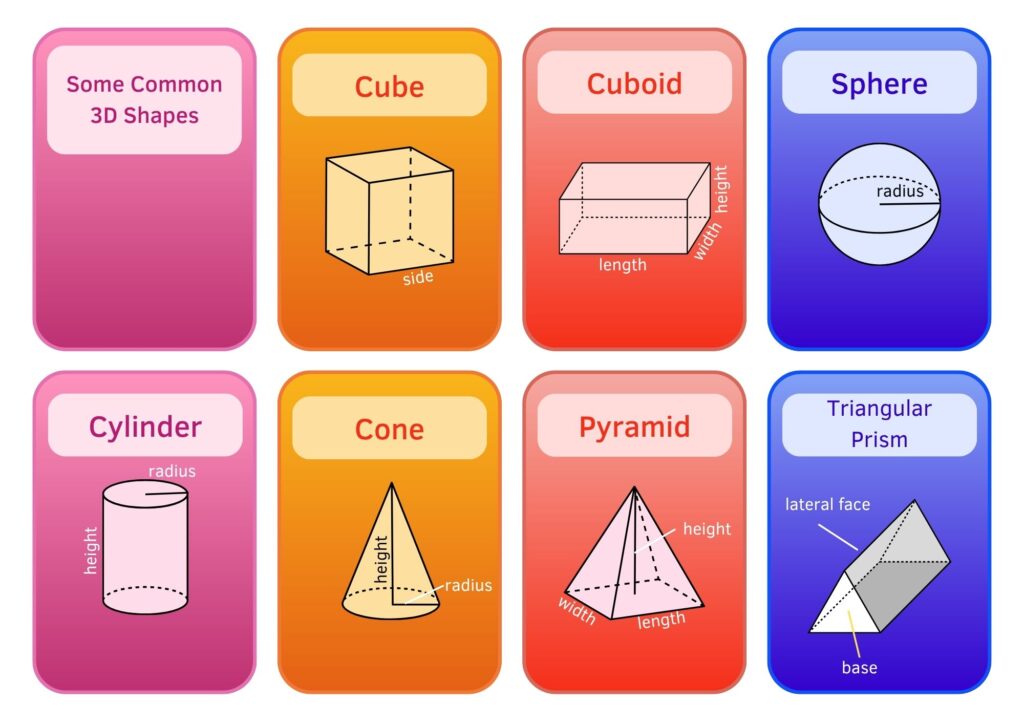
Example:
- Cube (like a dice)
- Cuboid (like a box)
- Cylinder (like a can)
- Sphere (like a ball)
- Cone (like an ice cream cone)
Takeaway:
Look around your home — your refrigerator is a cuboid, and your football is a sphere!
Exploring Angles
An angle is formed when two lines meet at a point. That meeting point is called the vertex. Angles help us describe turns, corners, and directions.

Types of Angles:
| Type | Measure | Example |
|---|---|---|
| Acute Angle | Less than 90° | The tip of a slice of pizza |
| Right Angle | Exactly 90° | The corner of your notebook |
| Obtuse Angle | More than 90° but less than 180° | A half-open door |
| Straight Angle | Exactly 180° | A straight line |
| Reflex Angle | More than 180° | A clock showing 7 o’clock |
Takeaway:
Angles are everywhere — from the corners of your book to the roads turning left or right. Understanding them helps you measure shapes accurately.
Triangles – The Strongest Shape!
A triangle is a 2D shape with three sides and three angles. It’s one of the most important shapes in geometry.
(A) Types of Triangles by Sides:
- Equilateral Triangle → All sides are equal.
- Isosceles Triangle → Two sides are equal.
- Scalene Triangle → All sides are different.
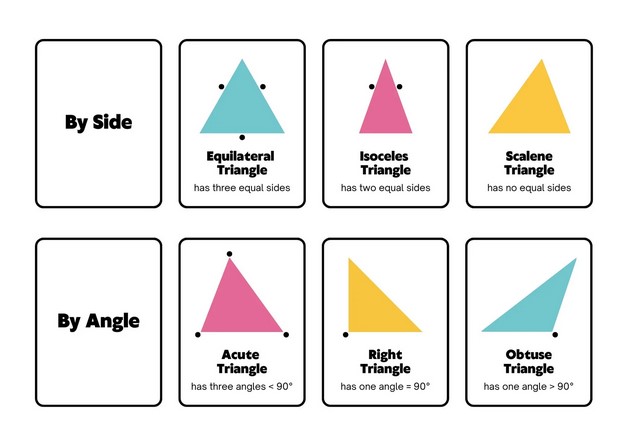
(B) Types of Triangles by Angles:
- Acute-angled Triangle → All angles are less than 90°.
- Right-angled Triangle → One angle is 90°.
- Obtuse-angled Triangle → One angle is more than 90°.
Takeaway:
- Triangles are used in building bridges and towers because they are strong and stable!
Quadrilaterals – The Family of Four Sides
A quadrilateral is a 2D shape with four sides and four corners.
Types of Quadrilaterals:
- Square → All sides equal and all angles 90°.
- Rectangle → Opposite sides are equal and all angles are 90°.
- Parallelogram → Opposite sides are parallel and equal.
- Rhombus → All sides are equal but no right angles.
- Trapezium → One pair of opposite sides parallel
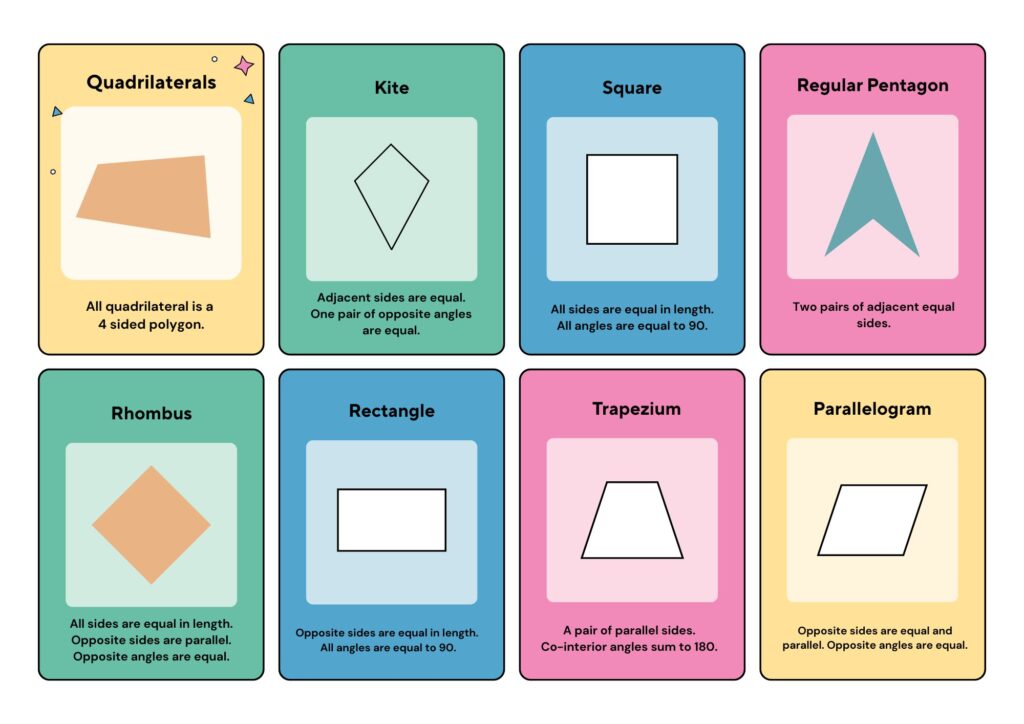
Takeaway:
- Windows, books, and doors are all examples of quadrilaterals in our daily life.
Circles – The Perfect Curves
A circle is a shape with all points at the same distance from its center.
Parts of a Circle:
- Center – The middle point.
- Radius – Line from center to the boundary.
- Diameter – Line passing through the center (2 × radius).
- Circumference – The boundary line around the circle.
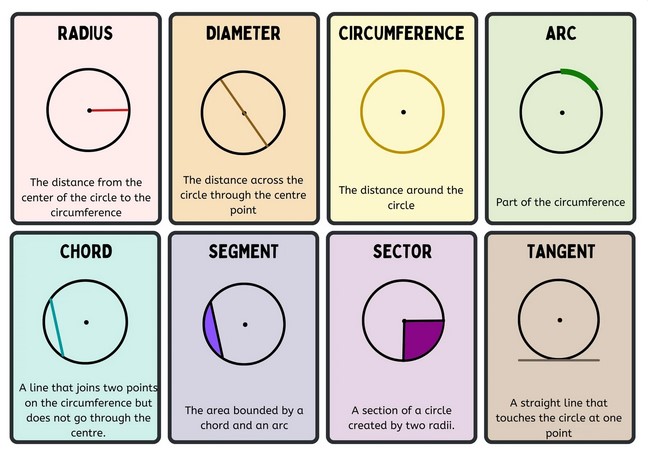
Takeaway:
- The wheel of a cycle, coins, and plates are perfect examples of circles.
Understanding Symmetry
Symmetry means balance and beauty in shapes!
A figure is symmetrical if you can fold it into two halves that match exactly.
Example:
- A butterfly, a heart, and a human face exhibit symmetry.
- The letter A has one line of symmetry.
Line of Symmetry:
The imaginary line that divides a figure into two halves is called the line of symmetry.
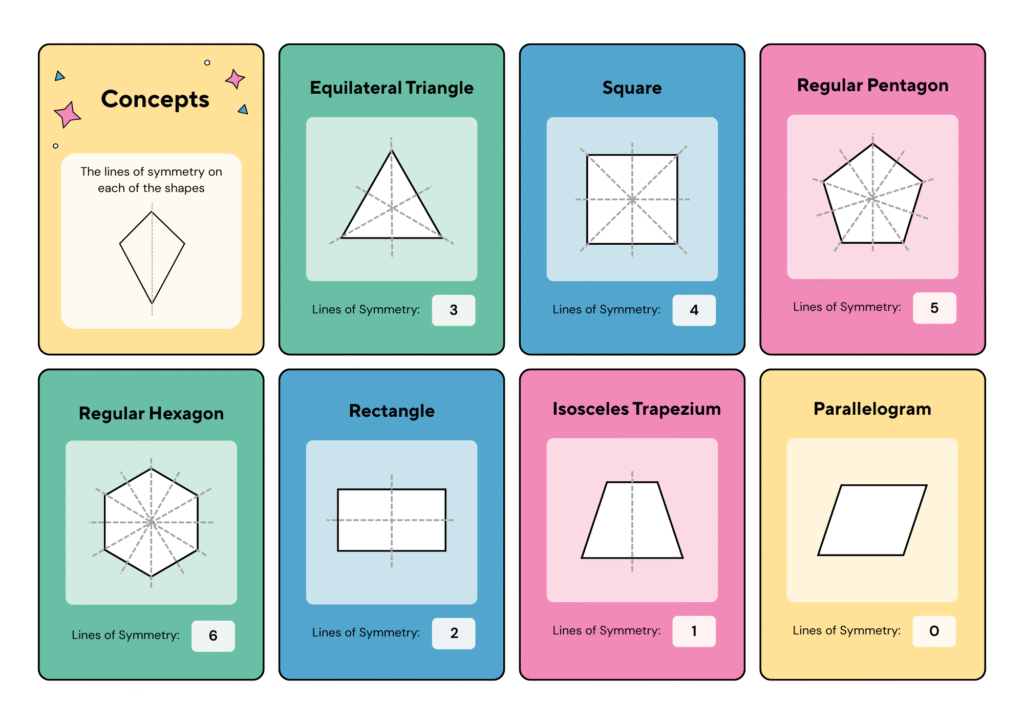
Takeaway:
- When you fold a paper heart or snowflake, both sides match — that’s symmetry in action!
Why Geometry is Important
Geometry helps us:
- Understand designs and patterns.
- Measure land and buildings.
- Build bridges, roads, and machines.
- Improve drawing and problem-solving skills.
Important Facts
Fun Fact:
- Did you know ancient Egyptians used geometry to build pyramids more than 4000 years ago?
- Geometry comes from Greek words meaning “Earth measurement.”
- The sum of all angles in a triangle is 180°.
- A square has 4 lines of symmetry.
- A circle has infinite lines of symmetry.
- The Earth is roughly spherical (3D shape).
- Architects and engineers use geometry to design buildings and bridges.
- Every 3D shape has faces, edges, and vertices.
- A cube has 6 faces, 12 edges, and 8 vertices.
Real-Life Connection of Geometry
Geometry is not just in textbooks — it’s in real life too!
At Home:
- Tiles on the floor are squares and rectangles.
- Ceiling fans have circular symmetry.
At School:
- The board is a rectangle.
- A protractor helps you measure angles.
In Nature:
- Honeycombs are hexagons.
- Snowflakes have perfect symmetrical designs.
Takeaway:
- The more you observe, the more shapes you’ll find around you!
Summary
Geometry makes the world around us understandable and beautiful. It teaches us how to see order, balance, and structure in things.
In this chapter, we learned about:
- 2D and 3D shapes
- Angles and triangles
- Quadrilaterals and circles
- Symmetry in nature and art
So next time you see a football, pizza slice, or window — remember, it’s geometry at work!
Practice Questions:
A. Fill In The Blanks.
- A closed figure made up of straight lines is called a ____________.
- A square has ____________ sides and ____________ corners.
- A circle has ____________ line(s) of symmetry.
- The angle formed by two rays meeting at a point is called an ____________.
- A triangle has ____________ sides and ____________ angles.
- A line that divides a figure into two halves is called the ____________ of symmetry.
- The shape of a dice is a ____________.
- The distance around a circle is called its ____________.
- The sum of all angles in a triangle is always ____________ degrees.
- All sides of a square are ____________.
Answers
- Polygon
- Four, four
- Infinite
- Angle
- Three, three
- Line
- Cube
- Circumference
- 180
- Equal
B. Match The Following.
| Column A | Column B |
|---|---|
| 1. Circle | a. Four equal sides |
| 2. Rectangle | b. Three sides |
| 3. Square | c. Curved boundary |
| 4. Triangle | d. Two pairs of equal sides |
| 5. Line of Symmetry | e. Divides a figure into equal halves |
Answers
- c
- d
- a
- b
- e
C. Short Answer Questions.
- What is the difference between 2D and 3D shapes?
- What are the types of triangles based on sides?
- Define symmetry. Give one example.
- What is a right angle?
- Write two examples of symmetrical objects from nature.
- What are polygons?
- Name the types of quadrilaterals.
- What is the center of a circle?
Answers
- 2D vs 3D Shapes:
- 2D shapes are flat and have only length and breadth (e.g., a square).
- 3D shapes have length, breadth, and height (e.g., cube).
- Types of triangles by sides:
- Equilateral
- Isosceles
- Scalene
- Symmetry:
- When one half of an object matches the other half exactly.
- Example: A butterfly’s wings.
- Right angle:
- An angle that measures exactly 90°.
- Examples of symmetry in nature:
- Butterfly, leaf, flower petals.
- Polygons:
- Closed figures with three or more straight sides.
- Types of quadrilaterals:
- Square, rectangle, parallelogram, rhombus, trapezium.
- Center of a circle:
- The fixed point is equidistant from every point on the circle.
D. Word Problem
- Name one object in your classroom that looks like:
- a) A rectangle
- b) A circle
- c) A triangle
- Draw and name a shape that has:
- a) 3 sides
- b) 4 equal sides
- c) No sides
- A clock shows 3 o’clock. What kind of angle is formed between the hour and minute hands?
- A pizza slice forms what kind of triangle?
- If you fold a paper heart and both sides match exactly, what geometric property does it show?
Answers
- Objects in the classroom:
- Rectangle → Blackboard
- Circle → Clock
- Triangle → Drawing instrument or flag
- Draw and name:
- 3 sides → Triangle
- 4 equal sides → Square
- No sides → Circle
- 3 o’clock angle:
- Right angle (90°)
- Pizza slice:
- Isosceles triangle
- Paper heart symmetry:
- Line of symmetry
E. Higher Thinking Questions
- Can a shape have more than one line of symmetry? Give an example.
- How is a square different from a rectangle?
- Which 3D shape looks like a can of cold drink?
- What would happen to a shape’s symmetry if one side is longer than the other?
- Which angle is smaller — acute or right?
Answers
- More than one line of symmetry:
- Yes, e.g., square (4 lines), circle (infinite lines).
- Square vs Rectangle:
- Both have right angles, but a square has all sides equal; rectangle has only opposite sides equal.
- Can shape:
- Cylinder
- Unequal sides and symmetry:
- The shape will lose its symmetry.
- Smaller angle:
- Acute angle
Supplementary Materials:
Provide downloadable materials for learners to review:
- – PDF Guide: “Coming Soon”
- – Cheat Sheet: “Coming Soon”
- – Video Source: “JNG ACADEMY“
- – Articles: “Blog Page“
FAQs:
Q1. What is geometry?
Q2. What is a line of symmetry?
Q3. What is the difference between a square and a rectangle?
Q4. How many sides does a triangle have?
Q5. What are 3D shapes?
Q6. What is an angle?
Q7. How many lines of symmetry does a circle have?
Q8. Where do we see symmetry in real life?
More Links:
Paid Earning Courses:
Other Chapters:
Share Your Valuable Thoughts:
What’s one real-life situation where you used perimeter or area without realizing it?
Share your thoughts in the comments below — or tell your teacher and classmates in class discussion!
